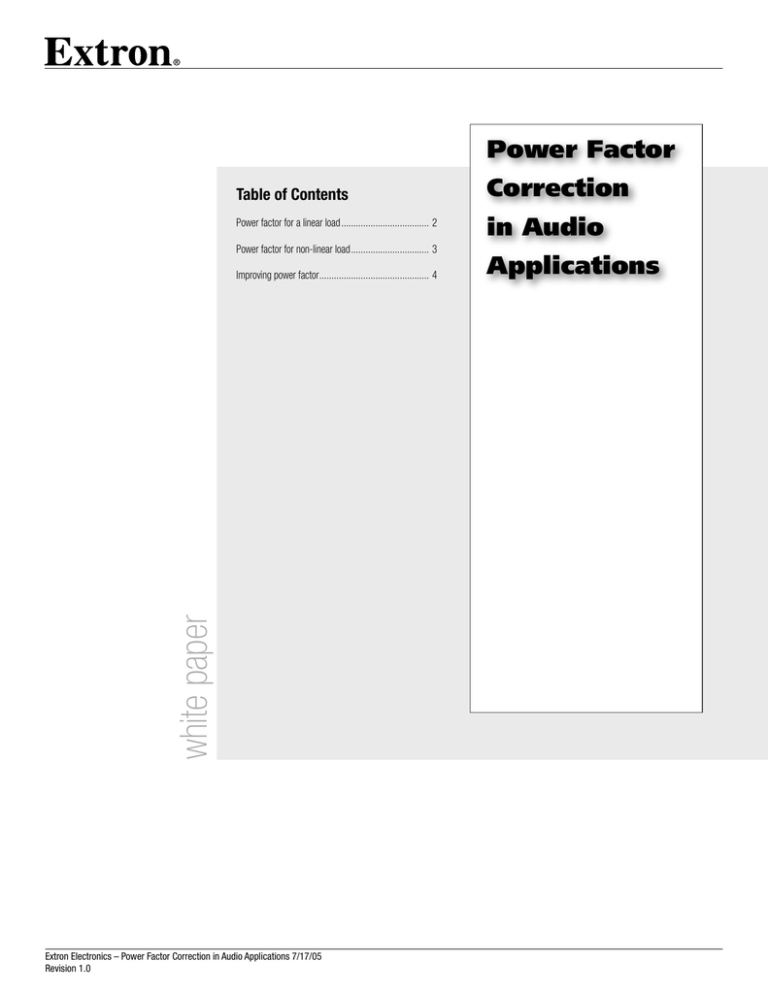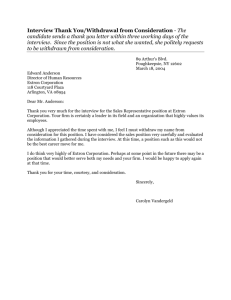
Power Factor
Table of Contents
Power factor for a linear load .................................... 2
Power factor for non-linear load ................................ 3
white paper
Improving power factor ............................................. 4
Extron Electronics – Power Factor Correction in Audio Applications 7/17/05
Revision 1.0
Correction
in Audio
Applications
white paper
Power Factor is related to the current drawn from the AC line by a load. In this paper
power factor is discussed for linear and nonlinear loads.
Power Factor for a linear load as shown in Fig. 1a is defined as:
pf = VA cos Θ
where pf = power factor
V = RMS of AC line voltage
A = RMS of AC line current I
Θ = phase angle
This case involves resistive, inductive or capacitive loads, whose impedance can be
characterized as a simple magnitude and phase angle. This would be the case for an
AC motor or an incandescent lamp, for example. It is included for background purposes,
but most presently available electronic equipment is nonlinear from the standpoint of
the AC line.
We see that the frequency of the AC line current is the same as the frequency of the AC
line voltage, but the phase angle may vary. the harmonic content is shown in Fig. 1b
Fig. 1
Extron Electronics – Power Factor Correction in Audio Applications 7/17/05
Revision 1.0
2
white paper
Power Factor for nonlinear loads as shown in Fig. 2a is defined as:
pf = W / VA
where pf = power factor
W = true power draw
V = RMS of AC line voltage
A = RMS of AC line current I
This case involves a nonlinear element such as a rectifier. The two most common cases
are shown in Fig. 2a, these are a rectifier/capacitor as used in a switchmode power
supply, and a transformer/rectifier/capacitor as used in a line frequency power supply.
In these circuits the diodes can only conduct when the AC line voltage is greater than the
capacitor voltage, which leads to large current spikes at the peak of the AC waveform. In
this case the harmonic content of the AC current will contain harmonics of the AC line
voltage, usually up to several kHz. The harmonic content is shown in Fig. 2c.
The importance of the power factor of nonlinear loads becomes apparent when dealing
with a three phase system. Historically, most office buildings were constructed before
electronic fluorescent lamp ballasts and personal computers were the norm. Instead,
linear loads such as incandescent bulbs were used. A safety problem occurred that
resulted from the increased use of nonlinear loads with poor power factor, that is, high
AC line harmonic content. This was due to the fact that in a Wye configured three phase
AC system all harmonics from all three phases must flow in the ground conductor.
Fig. 2
With poor power factor, the sum of all these harmonics can exceed the load current
on any one leg, so a heavily loaded system may have an overcurrent on the ground
conductor, which of course cannot be protected with a circuit breaker or fuse. This
caused some building fires, and subsequently the EU adopted standards to limit the
harmonic content of the line current on products as a requirement of the CE label. This
caused manufacturers of equipment such as shown in Fig. 2a to redesign.
Extron Electronics – Power Factor Correction in Audio Applications 7/17/05
Revision 1.0
3
white paper
A typical way of improving power factor is shown in Fig. 3a. In this popular scheme, a
separate switching power converter is used to shape the AC line current draw into a
sinewave. Since the converter operates only with a positive input voltage, it is placed
after the rectifier and must shape incoming current into a rectified sinewave. The current
shaping is done by closing a loop around the inductor current, then closing a second
loop around the output capacitor voltage. In this manner, a switching power supply can
present an almost purely resistive load to the AC line; harmonic content is shown in
Fig. 3c. We can see that the peak current has dropped dramatically, as has the harmonic
content.
The effects of poor power factor on system performance are mostly evident when the
current draw is high. For an audio system this usually means the power amplifiers.
If the amplifiers cause a high harmonic content to be present on the AC line, other
equipment on the AC line may be affected. The presence of high frequency harmonics
can cause audible artifacts in the system by working their way back into sensitive signal
processing gear that shares the same AC line.
A conventional electronic light dimmer also produces a current with a high harmonic
content; these devices are commonly encountered and are frequently a source of
system level noise, often leading to separation of branch circuits and in some cases
additional line isolation transformers to minimize the problem. Imagine if these dimmers
were installed in a rack full of sensitive audio gear with no way to separate the AC lines!
This is effectively what happens when a power amplifier with poor power factor is used
in a rack, although to a lesser degree.
Fig. 3
Extron Electronics – Power Factor Correction in Audio Applications 7/17/05
Revision 1.0
4
white paper
Extron Electronics, headquartered in Anaheim, CA, is a leading manufacturer of professional A/V system products including computer-video interfaces, switchers, matrix switchers,
distribution amplifiers, video scalers, scan converters, signal processing devices, Ethernet control interfaces, and high resolution cables. Extron products are used to integrate video
and audio into presentation systems for today’s high tech boardrooms, presentation/training centers, university lecture halls, and other applications.
For additional information, please call an Extron Customer Support Representative at: 800.633.9876 (inside USA and Canada only) or 714.491.1500 for Extron USA;
+800.3987.6673 (inside Europe only) or +31.33.453.4040 for Extron Europe; +800.7339.8766 or +65.6383.4400 for Extron Asia; +81.3.3511.7655 for Extron Japan.
www.extron.com
Copyright © 2005 All rights reserved.
Extron Electronics – Power Factor Correction in Audio Applications 7/17/05
Revision 1.0
5







